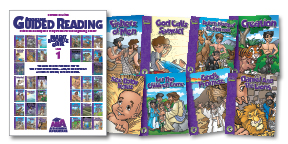The Concerned Group, Inc. has produced some great products for home educators, including A Reason for Writing series and A Reason for Science series. Their reading program caught my eye with its beautifully illustrated readers, all based on stories from the Bible. These readers are professionally illustrated and printed in full-color. Children are likely to want to pick these up to “read” the pictures as much as the stories. The readers are very brief, soft-cover books that range from 8 to 24 pages each. The 64 readers are grouped for three general reading levels: Emergent (22 readers), Transitional (38 readers), and Fluent (4 readers). However, even within those groups books proceed from level “A” through level “I” increasing in number of words as well as difficulty.
Advantage Guided Reading, Homeschool Edition, is a teacher’s manual with about 40 pages of general instruction at the beginning followed by 64 lesson plans, one for each of the 64 storybooks for the Emergent and Transitional levels. These detailed lesson plans are designed for two days to cover each storybook. A reproducible activity sheet is on the reverse of each lesson plan. At the back of the manual are suggestions for games and activities, record-keeping sheets, and three sheets of cardstock with small letter tiles (1.25” x 1.75”) that you can cut apart to use for a number of the activities.
The manual’s title says “Guided Reading,” and that is really the approach of this program. The parent/teacher guides a child through the stories, reading to them, reading with them, helping them read independently, all the while discussing and interacting with the story itself.
While Advantage Guided Reading is intended to be used as the primary teaching tool, I have some concern about using it as such since it has a minimal amount of phonics. It seems most useful for developing other reading strategies since it teaches many different strategies for reading, only one of which is sounding out words.
The program teaches some high-frequency words along with many unusual words. For example, in the first reader, Adam Named the Animals, children encounter the high-frequency words “this,” “is,” and “a,” as well as the names of six animals: cat, bear, rabbit, kangaroo, camel, and monkey. While “cat” is common to beginning phonics, the other words are not among those you would usually encounter in a beginning phonics-based program since they have very disparate phonetic elements.
One of the suggested strategies is posting high-frequency words on a “word wall” as they are introduced then have children review these words each week. These words are then used over and over again in more advanced readers. Other words like “kangaroo” might be introduced to the child but with no expectation of mastery at that point.
Some strategies like having the child guess what a word might be based on the illustration reflect sight-reading methods. (You can understand how this method is likely to be used in Adam Named the Animals.) Those who prefer intensive phonics might find this program an uncomfortable fit as a supplement if they want to use the teacher manual. However, they might use the readers on their own, perhaps more like library books than part of the core instruction.
Activity pages ask the child to “write a sentence about this book” along with other drawing or written activities. The instructions urge parents/teachers to think of writing activities as a way to “help your child initiate, reinforce, and extend his/her skill in reading as well as in writing” (p.28). To that end, “inventive spelling” is encouraged. This approach aligns well with the instructional methodology presented in the teacher’s manual but might conflict with other methods parents have chosen to use to instruct their children.
In my opinion, the combination of the teacher’s manual and readers is likely to be most useful as a supplement for helping children learn to enjoy reading with Bible-based stories. Children might well memorize these stories and “read” them back to themselves for fun.
In spite of my reservations, the methodology of the program reflects current research findings recommending that phonics be taught only as one of many reading skills, and Advantage Guided Reading is being used by both traditional and home schools as their primary reading program.
For “Fluent readers” there is an additional pack of 35 books. Four of these are repeats from the original pack of 64. The reading level within this set increases with books labeled as being for levels “I” through “M.” Instead of a manual for these Fluent readers, there is a pack of three-hole-punched pages printed on card stock. These are from the original classroom-designed version of the program and make reference to class groups in contrast to the Advantage Guided Reading manual with lessons written specifically for home educators. I expect that these cards will also be rewritten into another manual for home educators in the near future. Meanwhile, they are usable with only minor adaptations.
One of the most noticeable difference between activities on these cards in contrast to most of those in the teacher’s manual are the lengthier writing activities for the Fluent level readers. For example, one activity instructs the student to “Draw a picture of your favorite breakfast. In a few sentences, tell why this is your favorite breakfast.”
The reading level for the Fluent readers increases rather dramatically by the end of the series. In one of the final books, The Unexpected Guest, there are 484 words within 24 pages. Most pages have one or two fairly lengthy paragraphs with complex sentences such as, “’And now he is dead,’ Cleopas said, ‘crucified like a common criminal!’” This sentence structure and vocabulary might be challenging for most first graders.
You can check out the readers online for free. Amazingly, you can actually preview every page of all of the readers at the publisher’s website. (Click here to view readers.)









